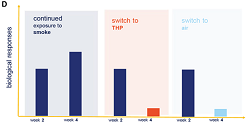Reducing risk

A new laboratory-based study has shown that when airway cells damaged by cigarette smoke are exposed instead to vapor from the heated-tobacco product, glo, some of the biological effects caused by the smoke exposure are reversed.
Basically, subsequent exposure of cigarette-smoke-impacted cells to glo vapor had a similar effect to their subsequent exposure to air – the cells were able to maintain their ability to repair themselves.
In a press note, British American Tobacco said that the vapor produced by glo contained about 90-95 percent less of certain toxicants than did cigarette smoke.
The company said that previous studies had shown that the biological impact of glo vapor on cells tested in the laboratory was much less than the impact of cigarette smoke on similar cells. But, it added, the reversibility of the damage following switching to a product such as glo had not been extensively studied.
“Products like glo are very new, so understanding the biological impact of vapor from glo and how that compares to cigarette smoke is a core component of our scientific research,” said Dr. James Murphy, head of reduced risk substantiation at BAT.
In the study, human airway cells were exposed repeatedly to either cigarette smoke or vapor over four weeks. For the first two weeks, the lung tissue was exposed to cigarette smoke for 15 minutes at a time, three times a week. The exposed tissue was then split into three groups: one group continued to be exposed repeatedly only to cigarette smoke for a further two weeks; a second group was exposed repeatedly to glo vapor and the third group was exposed only to air. The results obtained were then compared to results obtained by exposing airway tissue only to air for the full four weeks.
‘The results show that switching completely to glo after two weeks of repeated exposure to cigarette smoke reversed some of the biological impacts of the smoke,’ the press note said. ‘Significant reductions were observed in the amount of certain molecules produced in response to inflammation, for example, in comparison to that seen in lung tissue exposed to cigarette smoke for the full four-week period.’
BAT said the results added to evidence suggesting that glo might have the potential to be reduced risk compared to conventional cigarettes.
“We have developed a suite of tests to assess our next generation products, because we know it is by taking the results of all these tests together that gives us a real feel for the bigger picture and the potential for glo to be reduced risk compared to a conventional cigarette,” said Murphy.
The results are being presented today at the annual conference of the Society of Toxicology in San Antonio, Texas, US.